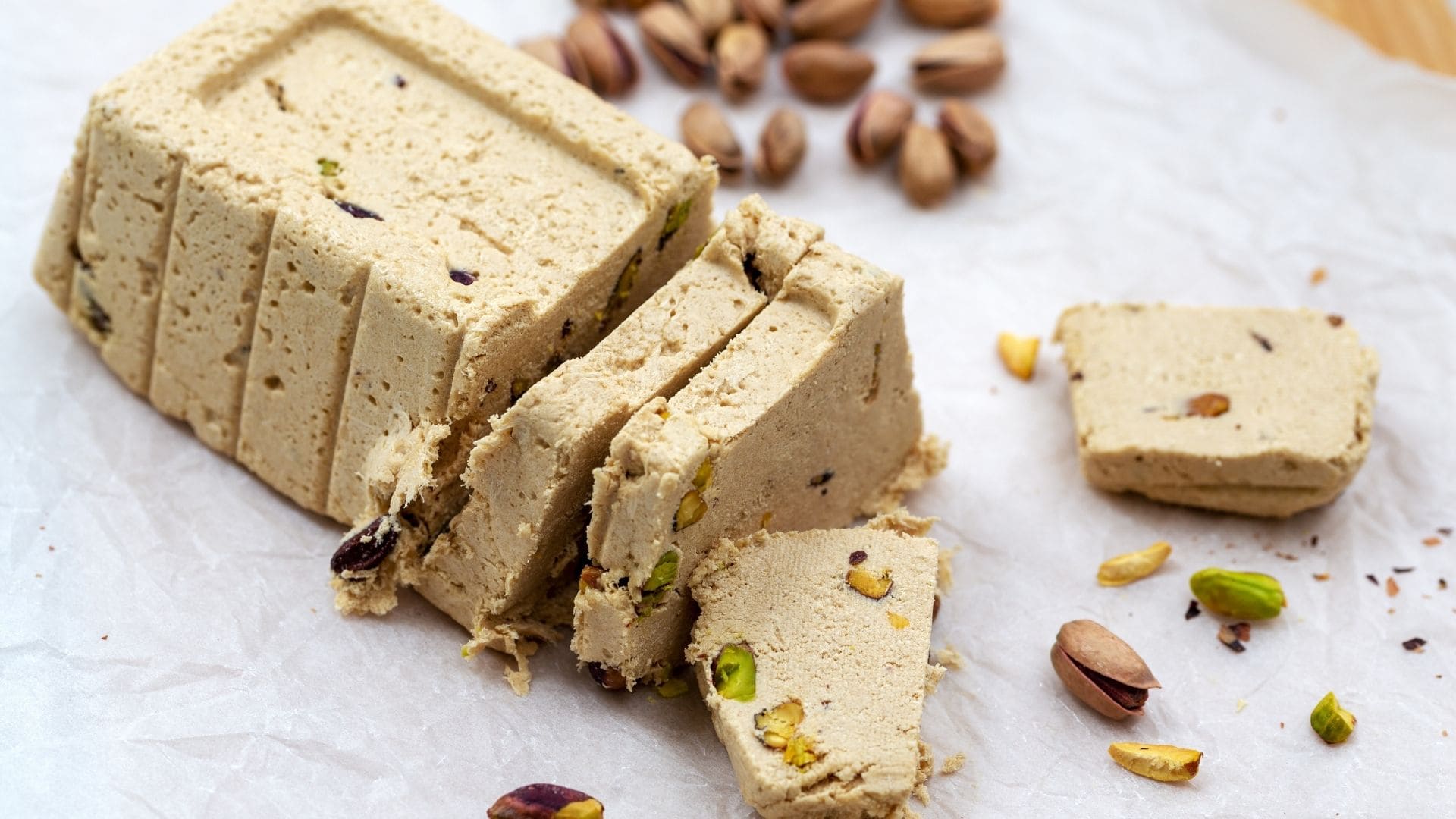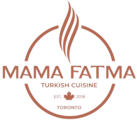Halva, or helva as it’s known in Turkey, is more than just a sweet treat—it’s a deeply rooted symbol of culture, tradition, and community. Found on tables during celebrations, ceremonies, and even everyday meals, halva has been an integral part of Turkish cuisine for centuries. At Mama Fatma, located in Toronto, Ontario, Canada, we honor these rich traditions by incorporating halva into our menu, offering both traditional and modern variations of this beloved dessert.
In this blog, we’ll explore the history and origins of Turkish halva, its different types, and how this simple yet flavorful confection continues to play a significant role in Turkish life. Whether you’re new to halva or a long-time fan, this guide will help you appreciate its cultural importance and give you a few ideas on how to enjoy it in your own home.
Blog Contents
ToggleHistory and Origins of Turkish Halva
The origins of halva can be traced back to ancient times, with some historians pointing to the Middle East and South Asia as the places where this sweet delicacy first appeared. The word “halva” comes from the Arabic word ḥalwā, which means “sweet.” Over the centuries, halva spread across different regions, each adapting the recipe to suit local tastes and ingredients. Turkey became one of the many countries where halva took on a distinct cultural identity.
In Turkey, halva is more than just a dessert; it carries religious and spiritual significance as well. Traditionally, it has been served during important life events such as births, weddings, and funerals, symbolizing sweetness and comfort in both joyous and sorrowful times. One of the most common types, tahini-based halva, became a staple in Turkish homes, made from simple ingredients such as sesame paste (tahini), sugar, and water.
At Mama Fatma, we continue to respect these traditions by offering authentic Turkish halva as part of our menu, connecting our guests in Mississauga to the rich culinary history of Turkey.

Different Types of Halva and Their Ingredients
Halva comes in many different varieties, each with its own unique flavor and texture. While sesame-based halva is perhaps the most well-known in Turkey, there are several other types that you’ll find in Turkish households and restaurants.
- Tahini Halva: The most iconic variety of Turkish halva, tahini halva is made with sesame paste, sugar, and sometimes flavorings like vanilla or cocoa. Its crumbly yet smooth texture makes it a favorite in both traditional and modern Turkish cuisine. Some versions also include nuts such as pistachios or walnuts for added flavor and crunch.
- Semolina Halva (irmik helvası): This type of halva is quite different in both texture and preparation. Made from semolina, butter, milk, and sugar, it is cooked slowly to achieve a rich, soft consistency. It is often served warm and can be topped with pine nuts or cinnamon for extra depth of flavor. Semolina halva is commonly served at religious ceremonies or as a comforting dish during the winter months.
- Flour Halva (un helvası): Another popular type, flour halva is made by toasting flour with butter and then sweetening it with a sugar syrup. The result is a dense, melt-in-your-mouth texture that is both hearty and sweet. It is often served in large gatherings and religious ceremonies in Turkey.
Each of these varieties has its own cultural context and place in Turkish cuisine, and at Mama Fatma, we love showcasing the versatility of halva by incorporating it into our desserts. Whether you’re trying tahini halva or a warm bowl of semolina halva, each bite is a connection to Turkish culinary heritage.
Traditional Recipes for Homemade Halva
For those interested in making halva at home, the good news is that it’s relatively simple to prepare, requiring only a few key ingredients. Below, we’ll share a basic tahini halva recipe, one of the easiest types to make at home, and a recipe for semolina halva, which is a bit more involved but equally delicious.
Tahini Halva Recipe (Basic)
Ingredients:
- 1 cup tahini (sesame paste)
- 1 cup sugar
- ½ cup water
- Vanilla extract (optional)
- Nuts (optional)
Instructions:
- Start by dissolving the sugar in water over medium heat. Allow it to come to a gentle boil until the sugar is fully dissolved, forming a syrup.
- Remove the syrup from heat and slowly stir in the tahini, whisking continuously until the mixture becomes smooth and well-combined.
- Add in any flavorings like vanilla or cocoa powder, and fold in nuts if you prefer.
- Pour the mixture into a mold or loaf pan and allow it to cool at room temperature. Once firm, cut into squares or slices.
Semolina Halva Recipe (Irmik Helvası)
Ingredients:
- 1 cup semolina
- ½ cup butter
- 1 cup sugar
- 1 ½ cups milk
- 1 cup water
- Pine nuts (optional)
Instructions:
- Melt the butter in a large pan and add the semolina, stirring constantly until it turns golden brown and gives off a nutty aroma. This step is key to developing the flavor.
- In a separate pot, dissolve the sugar in milk and water, then bring it to a gentle simmer.
- Slowly add the sweetened milk mixture to the semolina, stirring constantly to prevent lumps. Continue to cook until the mixture thickens and the semolina absorbs the liquid.
- Once fully cooked, remove from heat, cover the pot, and let it sit for about 10 minutes to finish steaming.
- Serve warm, optionally garnished with pine nuts or cinnamon.
By following these traditional recipes, you can enjoy the taste of Turkish halva from the comfort of your own home. At Mama Fatma, we prepare these halvas with love and care, using high-quality ingredients to preserve the authentic flavors.

The Role of Halva in Turkish Celebrations
In Turkey, halva holds a special place in many celebrations and religious ceremonies. It is often associated with births, weddings, and funerals, where it serves as a symbol of both joy and remembrance.
During weddings, halva is traditionally given as a sweet gift to guests, symbolizing the sweetness of the newlyweds’ union. At funerals, flour halva is often prepared and shared among family members and friends as a sign of respect and comfort for the departed. This blend of joy and sorrow reflects the deep emotional connection halva holds in Turkish culture.
In modern Turkish households, halva is also enjoyed during major holidays like Eid and other festive gatherings. It’s common to serve tahini halva as part of a larger spread of sweets and desserts during these celebrations, ensuring that everyone enjoys a taste of this culturally significant treat.
At Mama Fatma, we continue these traditions by offering halva on our menu during special holidays and celebrations, bringing a taste of Turkish culture to our guests in Mississauga.
Modern Twists on Classic Halva Recipes
While traditional halva is still beloved, modern chefs and home cooks alike have begun to experiment with new twists on this ancient dish. From incorporating chocolate and fruit flavors to using innovative ingredients like matcha or espresso, halva has found a new audience in the contemporary food scene.
For example, chocolate-tahini halva has become a trendy dessert, blending the nutty richness of tahini with the smooth sweetness of chocolate. Some cooks also like to add dried fruits like apricots or figs into the mix, creating a balance of textures and flavors that make halva feel fresh and exciting.
At Mama Fatma, we’ve embraced these modern interpretations while staying true to the traditional essence of halva. Our menu features both classic and innovative variations, allowing guests to experience halva in a variety of delicious forms.

How to Enjoy Halva: Serving Suggestions
There are many ways to enjoy halva, from a simple slice with tea to incorporating it into more elaborate desserts. In Turkey, halva is often served as an accompaniment to Turkish coffee or tea, making it a perfect afternoon treat. You can also crumble tahini halva over yogurt or ice cream for a unique twist on classic desserts.
For a more formal presentation, you can serve semolina halva warm, garnished with cinnamon or pistachios, creating a comforting and elegant dessert perfect for dinner parties. At Mama Fatma, we often serve halva alongside a selection of Turkish sweets, giving our guests a chance to experience a full range of flavors.
In conclusion, halva is much more than just a dessert—it’s a symbol of Turkish culture, tradition, and hospitality. From its ancient roots to modern interpretations, halva continues to hold a special place in the hearts and kitchens of those who love Turkish cuisine. Whether you’re enjoying it at Mama Fatma in Toronto, Ontario, Canada, or trying out a halva recipe at home, each bite offers a sweet connection to centuries of culinary history.

Turkish Sauces and What They’re Used For
In the world of Turkish cuisine, sauces are rarely just simple condiments; they are functional, flavor-enhancing masterpieces. Unlike the ubiquitous ketchup or mayonnaise found elsewhere, Turkish sauces—or more accurately, dips

How to Order Turkish Food for the First Time: A Stress-Free Guide
Trying a new cuisine is an adventure—a mix of excitement and maybe a little nervousness when looking at an unfamiliar menu. You want to order something delicious, authentic, and something

Why Turkish Dining Is Ideal For Slow Evenings
In the constant rush of life in Toronto, Ontario, the evening often feels like another race against the clock. We eat quickly, distracted, and often leave the table feeling full

How Turkish Cuisine Connects Cultures
Food is perhaps the most universal language we share. It requires no translation, crosses every border, and speaks directly to memory and comfort. And among the world’s great traditions, Turkish

What Makes Turkish Pide Fillings So Creative
When you think of flatbreads with toppings, you probably think of pizza. But in Turkey, there is a culinary masterpiece that takes the concept of a savory filling to a

How To Order Turkish Food For Large Groups
Planning a dinner for a large group—a corporate event, a big family reunion, or a celebration with friends—can feel like navigating a culinary minefield. Everyone has different preferences, and the


